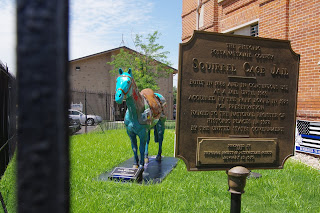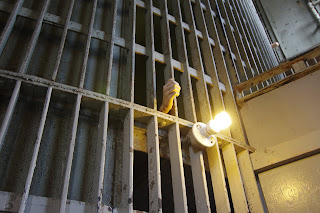Week of 7-15
to 7-21 in Omaha, NE
A few stops
during the week.
National Park Service Regional Office contains a small Lewis and Clark expedition exhibit.
The rear exit leads to a garden with a view of the Bob Kerrey Pedestrian Bridge separating Omaha from Council Bluffs.
Mormon Trail
Center at Historic Winter Quarters-Winter quarters served as the headquarters
of the Church for less than a year, until the leadership moved west in
1847.
Heartland of
America Park and Fountain is a public park in downtown Omaha. Lewis and Clark reportedly discovered earthen
mounds when they explored the location in 1804.
A paved
walking trail encircles the park where there are three fountains including a
large $1.5 million computerized fountain that projects water 300 feet into the
air.
We dined at
Old Chicago Pizza in Papillion.
Gerald R.
Ford Birth site and Gardens is a memorial to the 38th President of
the United States, born in Omaha. A
kiosk modeled after the original house’s turret contains birth site information
and presidential mementos. A colonnade
and Rose Garden modeled after the White House’s complete the site.
One evening
we rode our bicycles on the paved 3.1 mile loop around Walnut Creek Lake.
 One day we
visited the Western Historic Trails Museum-Council Bluffs, Iowa. This small center has exhibits about four
historic trails that passed through the area: the Lewis and Clark, Oregon,
California and Mormon Trails.
One day we
visited the Western Historic Trails Museum-Council Bluffs, Iowa. This small center has exhibits about four
historic trails that passed through the area: the Lewis and Clark, Oregon,
California and Mormon Trails.
 One day we
visited the Western Historic Trails Museum-Council Bluffs, Iowa. This small center has exhibits about four
historic trails that passed through the area: the Lewis and Clark, Oregon,
California and Mormon Trails.
One day we
visited the Western Historic Trails Museum-Council Bluffs, Iowa. This small center has exhibits about four
historic trails that passed through the area: the Lewis and Clark, Oregon,
California and Mormon Trails.
The exhibit space
includes photos, maps, some interactive pieces, sculptures and audio records.
We ended our
wonderful week in the Omaha area by attending a production of Hairspray at the
SumTur Amphitheater.

















































